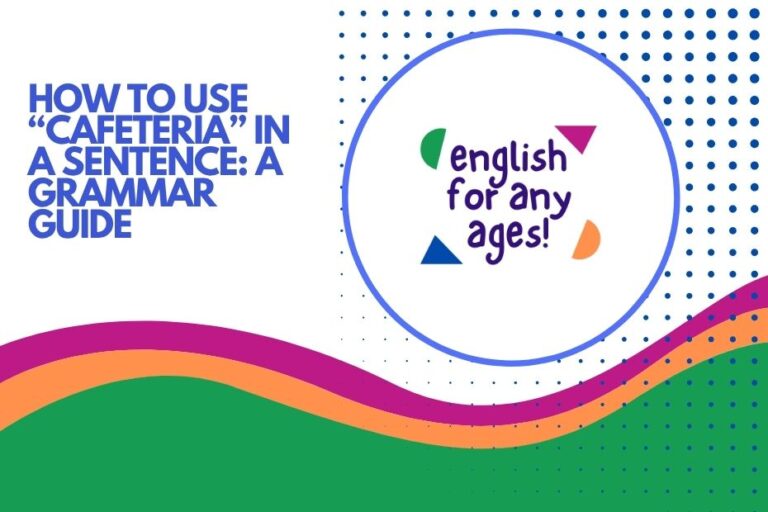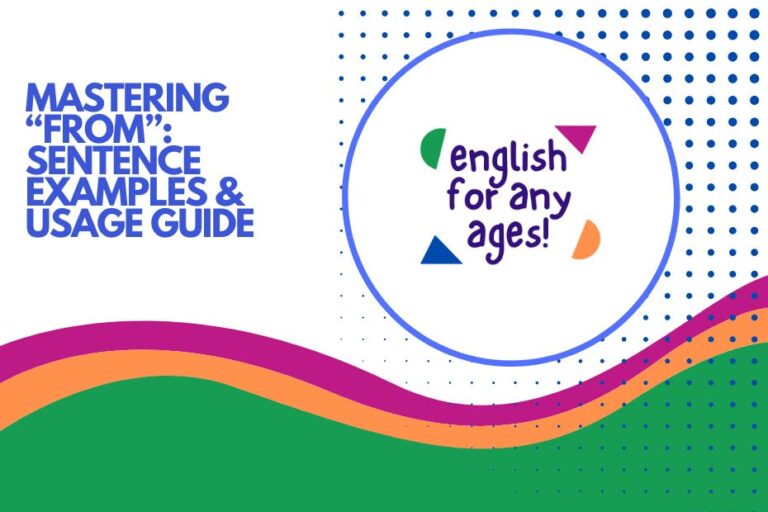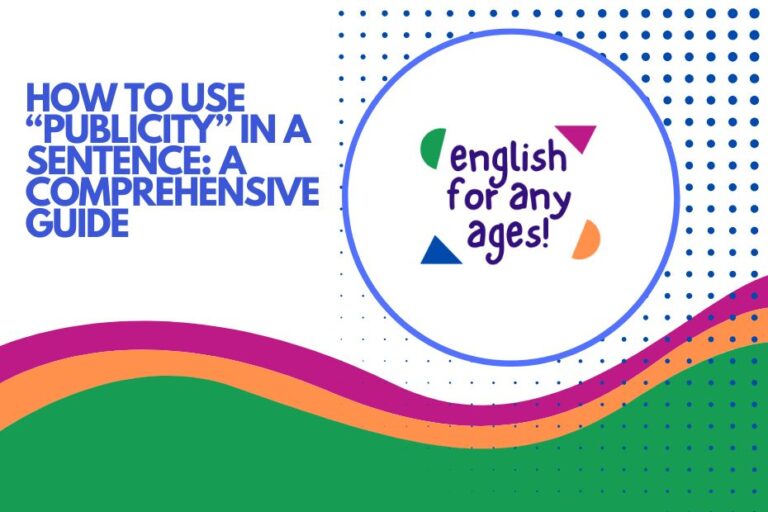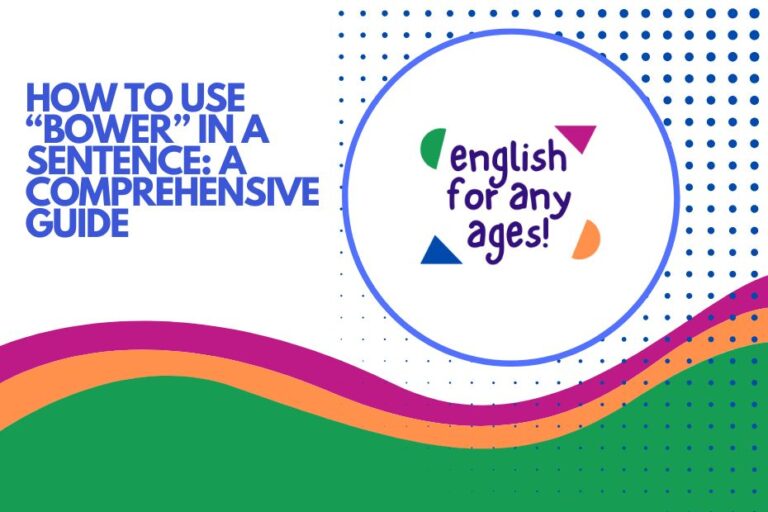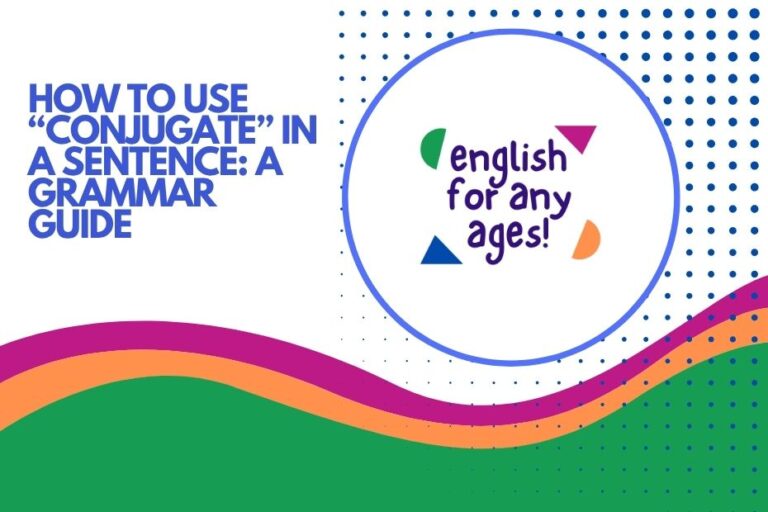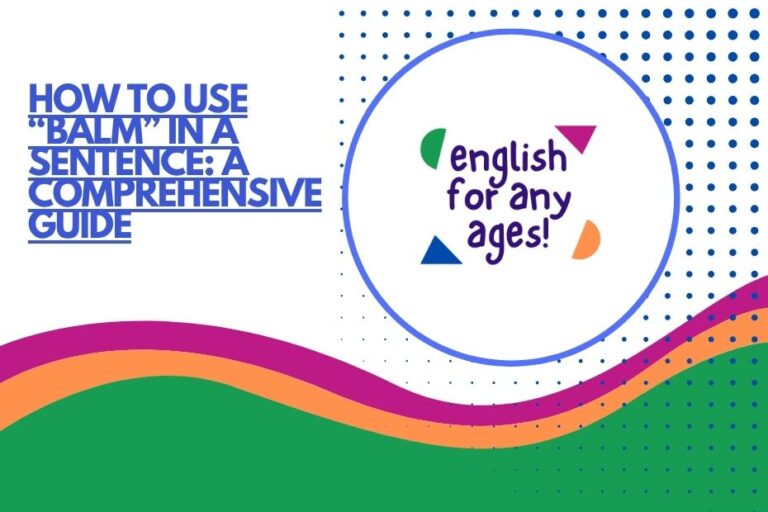Mastering “Up”: Sentence Examples and Usage Guide
The preposition “up” is deceptively simple. While it often indicates movement to a higher position, its versatility extends far beyond that.
Understanding the various ways “up” can be used – from expressing direction and location to forming phrasal verbs – is crucial for mastering English fluency and comprehension. This article provides a comprehensive guide to using “up” effectively, complete with numerous examples, explanations, and practice exercises.
Whether you’re a beginner or an advanced learner, this guide will help you confidently incorporate “up” into your everyday English.
Table of Contents
- Introduction
- Definition of “Up”
- Structural Breakdown
- Types of Usage
- Examples
- Usage Rules
- Common Mistakes
- Practice Exercises
- Advanced Topics
- FAQ
- Conclusion
Introduction
The English language is full of prepositions, and “up” is one of the most common and multifaceted. While its primary meaning relates to upward movement, “up” appears in a wide variety of contexts, impacting the meaning of sentences in subtle but significant ways.
This guide aims to equip you with a thorough understanding of “up,” enabling you to use it correctly and confidently in both spoken and written English. By exploring its various functions and providing numerous practical examples, we’ll demystify this seemingly simple preposition and unlock its full potential for your communication skills.
Definition of “Up”
The preposition “up” is primarily used to indicate movement to a higher position or location. However, its meaning extends beyond this literal definition to encompass notions of direction, location, time, state, condition, and completeness.
It is a highly versatile word that plays a crucial role in expressing spatial relationships, temporal aspects, and various abstract concepts. “Up” can function as a preposition, adverb, adjective, noun, or verb, though this article mainly focuses on its role as a preposition.
As a preposition, “up” always precedes a noun or pronoun (the object of the preposition) and connects it to another word in the sentence. It describes the relationship between the object and the other word, often indicating direction or position. The specific meaning of “up” depends heavily on the context in which it is used.
Structural Breakdown
The basic structure involving the preposition “up” is quite straightforward: [Verb] + up + [Noun/Pronoun]. The verb often indicates an action, and the noun or pronoun specifies the object or location related to that action. However, the structure can also be more complex, especially when “up” is part of a phrasal verb. In such cases, “up” combines with the verb to create a new meaning that may not be immediately obvious from the individual words.
Here are some common structural patterns:
- Movement: climb up the stairs, walk up the hill
- Location: up the street, up north
- Phrasal Verbs: look up a word, clean up the mess
Understanding these patterns is key to recognizing and interpreting the various uses of “up.” The context of the sentence will always provide clues about the intended meaning.
Types of Usage
The preposition “up” has several distinct types of usage, each conveying a different nuance. Understanding these types can greatly improve your comprehension and ability to use “up” correctly.
Direction
This is the most common and literal usage of “up,” indicating movement towards a higher point or position. It often involves physical movement, but can also refer to metaphorical “raising” of something.
Location
“Up” can also specify a general location, often indicating a position that is further north or inland. It might not always refer to a higher physical elevation.
Time
In some contexts, “up” can relate to time, often indicating that a period has ended or that something is approaching. This usage is less frequent than the directional or locational uses.
State or Condition
“Up” can describe a state or condition, often implying that something is in a good or improved state. This usage is frequently found in phrasal verbs.
Completeness or Termination
Often used in phrasal verbs, “up” can indicate that something is finished, completed, or used entirely. This is a common usage in everyday conversation.
Examples
To solidify your understanding, let’s explore various examples of “up” used in different contexts. These examples are categorized by the types of usage discussed above.
Direction Examples
The following table provides examples of “up” used to indicate direction, showing movement towards a higher position. Each example illustrates how “up” functions to describe physical or metaphorical ascent.
| Sentence | Explanation |
|---|---|
| The climber scaled up the mountain. | Indicates physical movement to a higher point on the mountain. |
| She walked up the stairs to her apartment. | Describes movement from a lower floor to a higher one. |
| The balloon floated up into the sky. | Specifies upward movement of the balloon. |
| He looked up at the stars. | Indicates the direction of his gaze. |
| The prices are going up due to inflation. | Metaphorical rise in prices. |
| The elevator went up to the tenth floor. | Describes the upward movement of the elevator. |
| The water level rose up after the heavy rain. | Indicates an increase in the water level. |
| She jumped up and down with excitement. | Describes repeated upward and downward movements. |
| The stock market climbed up steadily. | Metaphorical upward trend in the stock market. |
| They hiked up the steep trail. | Indicates an uphill hike. |
| The smoke billowed up from the chimney. | Describes the upward movement of smoke. |
| He pulled the rope up to lift the package. | Indicates pulling something upwards. |
| The bird flew up from the branch. | Describes the bird’s upward flight. |
| The curtain went up at the start of the play. | Indicates the raising of the curtain. |
| The temperature is creeping up. | Metaphorical increase in temperature. |
| He scrambled up the rocky slope. | Describes difficult upward climbing. |
| The kite soared up into the clouds. | Indicates the kite’s high upward flight. |
| She tiptoed up to the sleeping child. | Describes quiet, upward movement (towards the child’s location, which could be higher, like in a bed). |
| The rocket blasted up into space. | Indicates a powerful upward launch. |
| The sun came up over the horizon. | Describes the sun’s rising. |
| The costs have shot up recently. | Indicates a rapid increase in costs. |
| He pushed up from the floor after his workout. | Describes the action of pushing oneself upwards. |
| The hot air rose up from the pavement. | Indicates the rising of hot air. |
| The yeast made the dough rise up. | Describes the dough increasing in height. |
| She lifted the box up onto the shelf. | Indicates the action of lifting something to a higher place. |
Location Examples
This table illustrates the use of “up” to specify a general location, often indicating a position further north or inland. Note that “up” in these cases doesn’t always imply a higher physical elevation.
| Sentence | Explanation |
|---|---|
| He lives up north. | Indicates a location in the northern part of a region. |
| The shop is just up the street. | Specifies a location further along the street. |
| We’re going up to the mountains for vacation. | Indicates a trip to a mountainous region. |
| The cabin is located up the river. | Specifies a location further along the river’s course. |
| She grew up in a small town in the countryside. | Describes where she spent her childhood. |
| They have a house up in the hills. | Indicates a house located in the hills. |
| The farm is situated up the valley. | Specifies a location in the valley. |
| He walked up the road to the post office. | Indicates movement along the road to the post office. |
| The village is up on the plateau. | Specifies a location on the plateau. |
| They built their house up on the ridge. | Indicates a house located on the ridge. |
| The lake is up in the mountains. | Specifies a location in the mountainous region. |
| She drove up the coast to see the lighthouse. | Indicates a drive along the coast. |
| The old mill is up by the stream. | Specifies a location near the stream. |
| He found a quiet spot up in the woods. | Indicates a location within the woods. |
| The city is located up the river from here. | Specifies the city’s location relative to the river. |
| They have a summer home up in the country. | Indicates a summer home in the countryside. |
| The trailhead is up past the visitor center. | Specifies the trailhead’s location relative to the visitor center. |
| We went up to the lake for a swim. | Indicates a trip to the lake. |
| The best view is up on the hill. | Specifies the hill as the location with the best view. |
| The restaurant is up around the corner. | Indicates the restaurant’s location around the corner. |
| He’s working up in Scotland this summer. | Indicates he is working in the northern region. |
| The town is situated up in the highlands. | Describes its location in a higher elevated region. |
| Their farm is up a long, winding road. | Specifies the location of the farm relative to the road. |
| The hidden waterfall is up near the peak. | Indicates the falls are close to the mountain top. |
| We’re heading up to Maine for the holidays. | Describes a trip to Maine. |
Time Examples
The following examples demonstrate how “up” can be used in relation to time, often signifying the end of a period or the approach of an event. This usage is less common than the directional or locational senses of “up.”
| Sentence | Explanation |
|---|---|
| The time is up. | Indicates that the allotted time has ended. |
| My contract is up next month. | Specifies the end of the contract period. |
| His lease is coming up for renewal. | Indicates that the lease is nearing its end. |
| The deadline is fast approaching; time is nearly up. | Emphasizes the approaching end of the deadline. |
| The game is up; we know your secret. | Means “the game is over” or “the secret is out”. |
| Summer is nearly up. | Indicates that summer is coming to an end. |
| Her visa is up soon. | Specifies the approaching expiration of the visa. |
| The meeting is up at 5 PM. | Indicates the scheduled end time of the meeting. |
| The session is up in five minutes. | Specifies the remaining time in the session. |
| The sale is up at midnight. | Indicates the end time of the sale. |
State or Condition Examples
This table shows how “up” can describe a state or condition, often implying that something is in a good or improved state. This usage is frequently found within phrasal verbs.
| Sentence | Explanation |
|---|---|
| Are you up for a challenge? | Indicates a willingness or readiness to accept a challenge. |
| He’s feeling up today after being sick. | Describes an improved state of health. |
| She’s up to her ears in work. | Indicates being very busy or overwhelmed with work. |
| They’re up against a tough opponent. | Describes facing a difficult challenge or competitor. |
| The car is all fixed up. | Indicates that the car is in good condition after being repaired. |
| He’s up to no good. | Suggests that he is planning something mischievous or dishonest. |
| She tidied up her room. | Indicates that she made her room neat and orderly. |
| The team geared up for the final game. | Describes preparing or getting ready for the final game. |
| He dressed up for the party. | Indicates wearing formal or elegant clothing. |
| The company is scaling up its operations. | Describes expanding or increasing the scale of operations. |
| He’s all grown up now. | Describes someone who has matured. |
| She perked up when she heard the good news. | Indicates she became more cheerful. |
| They patched up their differences. | Describes resolving a disagreement. |
| He propped himself up in bed. | Indicates supporting himself in a sitting position. |
| We’re building up our savings. | Describes increasing the amount of savings. |
| The project is shaping up nicely. | Indicates the project is developing well. |
| He cheered up after receiving the gift. | Describes becoming happier. |
| The town is cleaning up after the storm. | Indicates restoring order and cleanliness. |
| He backed up his computer files. | Describes creating a copy for safety. |
| She wrapped up warmly before going out. | Indicates dressing to stay warm. |
Completeness Examples
This table illustrates how “up” can indicate completeness or termination, often within phrasal verbs. This denotes something is finished, completed, or entirely used.
| Sentence | Explanation |
|---|---|
| He finished up his work. | Indicates that he completed his work. |
| She used up all the milk. | Describes using all of the milk. |
| They ate up all the cookies. | Indicates finishing all the cookies by eating. |
| The store is closing up for the night. | Describes the store’s process of closing. |
| He summed up the main points of the presentation. | Indicates he provided a concise summary. |
| She wrapped up the meeting. | Describes bringing the meeting to a conclusion. |
| They cleaned up the entire house. | Indicates a thorough cleaning of the house. |
| He drank up his juice quickly. | Describes finishing the juice by drinking. |
| She filled up the gas tank. | Indicates completely filling the tank. |
| They used up all their vacation days. | Describes exhausting all available vacation days. |
| He used up all the paper in the printer. | Indicates no paper is left. |
| She sopped up the spill with a towel. | Describes absorbing all of the liquid. |
| The detective pieced up the clues. | Indicates gathering and assembling all the clues. |
| They divvied up the inheritance. | Describes distributing the entire inheritance. |
| He ate up the entire pizza. | Indicates consuming all of the pizza. |
| She scooped up the last bit of ice cream. | Describes taking the final portion of ice cream. |
| They used up all the funds on the project. | Indicates completely spending the allocated money. |
| He ate up every last crumb on the plate. | Describes consuming all the crumbs. |
| She soaked up the sun on the beach. | Indicates absorbing as much sunlight as possible. |
| The artist touched up the painting. | Describes completing the final details. |
| The children lapped up the story. | Indicates they listened with enthusiasm. |
| He buttoned up his coat. | Describes fastening all the buttons. |
| She gulped up the water after her run. | Indicates drinking quickly and completely. |
| We bottled up our emotions. | Describes suppressing feelings. |
| He packed up his belongings. | Indicates finishing packing everything. |
Usage Rules
While “up” is a versatile preposition, there are specific rules to follow to ensure correct usage. Understanding these rules will help you avoid common errors and use “up” with confidence.
- Direction: When indicating direction, “up” should be followed by the object of the movement (e.g., climb up the tree).
- Location: When specifying location, “up” is often used in conjunction with other prepositions like “in” or “on” (e.g., up in the mountains).
- Phrasal Verbs: Pay close attention to the meaning of phrasal verbs containing “up.” The meaning can be quite different from the literal meaning of “up” itself (e.g., look up means “to search for information”).
- Redundancy: Avoid using “up” redundantly. For example, saying “climb up the stairs up” is incorrect; use “climb up the stairs” or “climb the stairs.”
Common Mistakes
Even experienced English learners sometimes make mistakes when using “up.” Here are some common errors and how to correct them.
| Incorrect | Correct | Explanation |
|---|---|---|
| I going up the stairs. | I am going up the stairs. | Missing auxiliary verb “am.” |
| He looked up the sky. | He looked up at the sky. | The preposition “at” is needed to indicate direction. |
| She finished up already her work. | She has already finished up her work. OR She has already finished her work. | “Already” needs to be in correct position and “up” can be omitted for brevity. |
| He climed up the tree up. | He climbed up the tree. OR He climbed the tree. | Redundant use of “up.” |
| They are sit up. | They are sitting up. | Requires the present participle form “sitting.” |
| She used all up the milk. | She used up all the milk. | Correct word order in the phrasal verb. |
| I am interesting up in that. | I am interested in that. | Correct idiom is “interested in.” |
| He wake up late. | He wakes up late. | Correct verb tense and subject-verb agreement. |
Practice Exercises
Test your understanding of “up” with these practice exercises. Each exercise focuses on different aspects of using “up” correctly.
Exercise 1: Fill in the Blanks
Fill in the blanks with the correct preposition, “up.”
| Question | Answer |
|---|---|
| 1. The cat climbed ______ the tree. | up |
| 2. She looked ______ at the ceiling. | up |
| 3. They walked ______ the hill. | up |
| 4. The balloon floated ______ into the air. | up |
| 5. He lives ______ north. | up |
| 6. Are you ______ for the challenge? | up |
| 7. The time is ______. | up |
| 8. She tidied ______ her room. | up |
| 9. He finished ______ his work. | up |
| 10. The shop is just ______ the street. | up |
Exercise 2: Correct the Sentences
Correct the following sentences that contain errors in the use of “up.”
| Question | Answer |
|---|---|
| 1. I going up the stairs. | I am going up the stairs. |
| 2. She used all up the milk. | She used up all the milk. |
| 3. He climed up the tree up. | He climbed up the tree. OR He climbed the tree. |
| 4. They are sit up. | They are sitting up. |
| 5. He looked up the sky. | He looked up at the sky. |
| 6. She is interesting up in art. | She is interested in art. |
| 7. My contract is up on next month. | My contract is up next month. |
| 8. He is feeling more up than yesterday. | He is feeling better today than yesterday. |
| 9. I finish up already my homework. | I have already finished my homework. |
| 10. She is look up a word in the dictionary. | She is looking up a word in the dictionary. |
Exercise 3: Sentence Completion with Phrasal Verbs
Complete the following sentences using appropriate phrasal verbs with “up.”
| Question | Answer |
|---|---|
| 1. Please ______ the mess in the kitchen. | clean up |
| 2. I need to ______ a word in the dictionary. | look up |
| 3. They decided to ______ their old friendship. | patch up |
| 4. The company is planning to ______ its production. | scale up |
| 5. We need to ______ for the upcoming event. | gear up |
| 6. He ______ the ladder carefully. | climbed up |
| 7. She ______ her hair before the party. | put up |
| 8. They ______ the old building to make way for a new one. | tore down |
| 9. I ______ all my savings for this trip. | saved up |
| 10. She ______ a new hobby during the lockdown. | took up |
Advanced Topics
For advanced learners, exploring more nuanced aspects of “up” can further refine your understanding. This includes idiomatic expressions and subtle differences in usage depending on context.
- Idiomatic Expressions: “Up” appears in many idiomatic expressions with meanings that are not immediately obvious (e.g., “What’s up?” means “How are you?”).
- Regional Differences: The usage of “up” can vary slightly depending on the region or dialect.
- Figurative Language: “Up” can be used figuratively to express abstract concepts like hope, aspiration, or improvement.
FAQ
Here are some frequently asked questions about using the preposition “up.”
- What is the primary meaning of “up”?
The primary meaning of “up” is to indicate movement to a higher position or location. However, it also encompasses various other meanings related to direction, location, time, state, condition, and completeness. It’s a highly versatile preposition with a broad range of applications.
- How does “up” function in phrasal verbs?
In phrasal verbs, “up” combines with a verb to create a new meaning that may not be directly related to the literal meaning of “up.” For example, “look up” means “to search for information,” and “clean up” means “to tidy.” Understanding the specific meaning of each phrasal verb is crucial.
- Can “up” be used as something other than a preposition?
Yes, “up” can also function as an adverb (The balloon floated up), an adjective (the up escalator), a noun (the ups and downs of life), or a verb (to up the price). However, this article primarily focuses on its use as a preposition.
- What is the difference between “up to” and “up with”?
“Up to” generally indicates a limit, responsibility, or something one is capable of (e.g., It’s up to you). “Up with” is often used to show support or enthusiasm (e.g., Up with democracy!), though this usage is less common.
- How can I avoid using “up” redundantly?
Pay attention to the context and avoid repeating “up” when it’s not necessary. For example, instead of saying “climb up the stairs up,” simply say “climb up the stairs” or “climb the stairs.”
- Is it always necessary to include “up” in phrasal verbs?
In some cases, the “up” is essential to the meaning of the phrasal verb, while in others, it can be implied or omitted. For example, “finish up” and “finish” can sometimes be used interchangeably, but “look up” cannot be shortened to just “look” without changing the meaning.
- Are there any regional variations in the usage of “up”?
Yes, there can be slight regional variations in the usage of “up,” particularly in idiomatic expressions or colloquial speech. However, the core meanings and grammatical rules remain consistent across different regions.
- How can I improve my understanding of phrasal verbs with “up”?
The best way to improve your understanding of phrasal verbs with “up” is to study them in context, pay attention to their specific meanings, and practice using them in your own sentences. Dictionaries and online resources can be helpful for learning and memorizing phrasal verbs.
Conclusion
Mastering the preposition “up” is a key step towards achieving fluency in English. By understanding its various functions – from indicating direction and location to forming phrasal verbs – you can express yourself more accurately and confidently.
Remember to pay attention to the context, avoid redundancy, and practice using “up” in different situations. With consistent effort, you’ll be able to navigate the nuances of this versatile preposition and enhance your overall communication skills.
Continue to explore the examples provided, complete the practice exercises, and consult reliable resources whenever you encounter unfamiliar usages of “up.” With dedication, you can master this essential element of English grammar and elevate your language proficiency.

